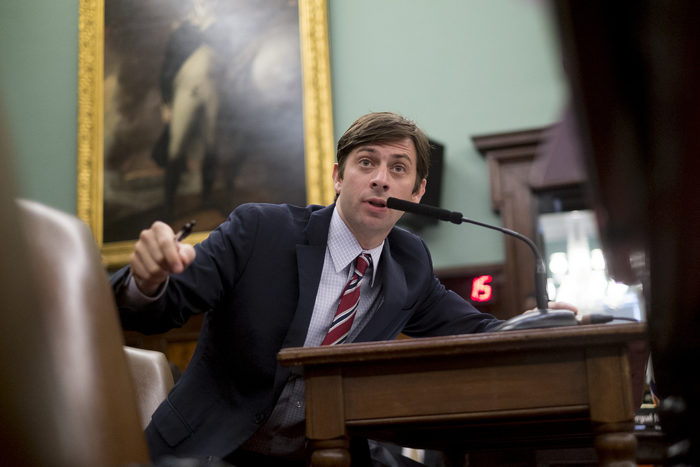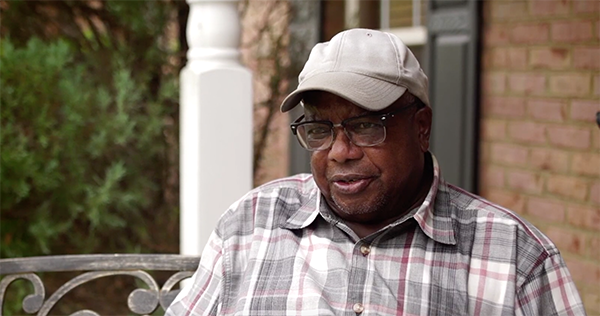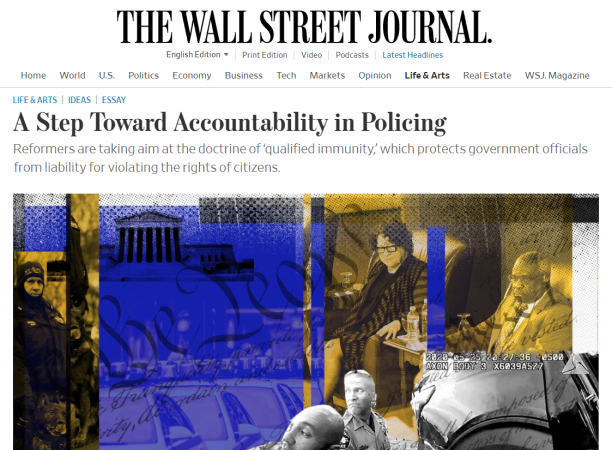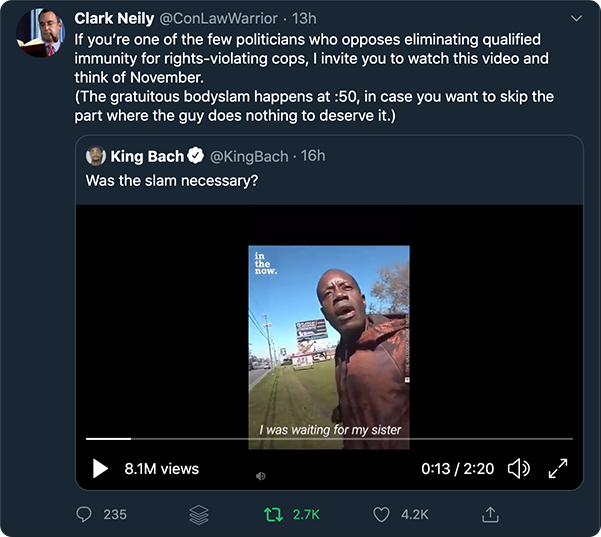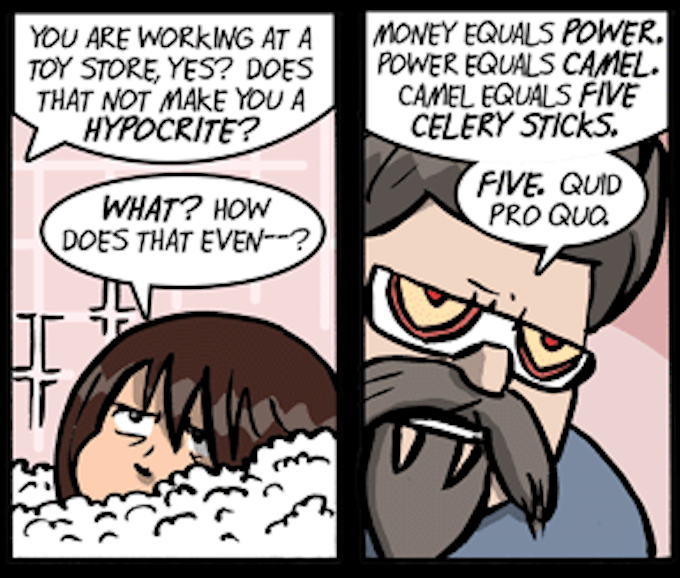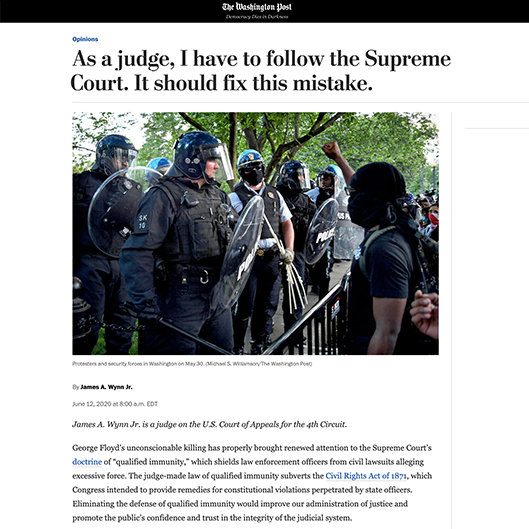Earlier this week, the Supreme Court issued two unsigned opinions in Rivas-Villegas v. Cortesluna and City of Tahlequah v. Bond, both of which summarily reversed lower-court opinions that had denied qualified immunity to police officers. The reasoning in the two opinions was nearly identical – in both cases, the Court held that the officers were entitled to immunity because there were no prior judicial decisions with sufficiently similar facts as these cases. These decisions aren’t especially noteworthy on their own terms, but they do provide further evidence that the Court is unwilling to reconsider any fundamental aspect of qualified immunity. To the contrary, the ordinariness of these opinions itself suggests that the Court wants the core of the doctrine to remain unchanged from how it’s been applied for decades.
To understand the significance of these otherwise mundane decisions, it’s important to start with last term’s decision in Taylor v. Riojas. This per curiam opinion summarily reversed the Fifth Circuit’s grant of immunity to corrections officers who had kept a man in inhumane prison conditions, and it marked the first time in sixteen years that the Court held that official conduct violated “clearly established law.” As I discussed in detail here, this was a noteworthy development, as it reaffirmed the basic principle from Hope v. Pelzer — long thought to be effectively inoperative as binding precedent — that at least some sufficiently obvious constitutional violations do not require cases exactly on point to hold that the law was clearly established.
But, as I cautioned here, the Taylor decision — while perhaps indicating that the Justices want to cut back on the most egregious applications of the doctrine — also suggested that the Justices are not interested in reconsidering qualified immunity entirely. After all, the Taylor petition presented exactly that fundamental question, and the Court declined to hear it on the merits, just as it did with many similar petitions in June 2020.
Monday’s twin decisions provide further evidence that the Justices are not prepared to make major alterations to qualified immunity. Both cases involved claims against police officers alleged to have used excessive force, and the Court’s per curiam opinions were very similar:
- Rivas-Villegas involved a group of police officers who responded to a 911 call from a family claiming that the mother’s boyfriend, Ramon Cortesluna, was in their house with a chainsaw and might hurt them. The officers arrived, knocked on the door, and ordered Cortesluna to come out and drop his “weapon” (a metal tool). He did so, but the officers saw also that he had a knife in his pocket and shot him twice with a beanbag round when he didn’t comply with their instructions. As they went to handcuff him, one of the officers, Daniel Rivas-Villegas, briefly put his knee on Cortesluna’s back. The Ninth Circuit denied immunity to Rivas-Villegas, holding that circuit precedent also involving “suspects who were lying face-down on the ground and were not resisting either physically or verbally, on whose back the defendant officer leaned with a knee” put him on notice that his actions could constitute excessive force. But the Supreme Court reversed, holding that this prior case law was “materially distinguishable” because the facts of this case involved a more volatile situation.
- In City of Tahlequah, officers responded to a 911 call from a woman who said that her ex-husband, Dominic Rollice, was intoxicated and in her garage. When the officers arrived and started talking to Rollice, he went into the garage and grabbed a hammer from the back wall. The officers ordered him to drop it, but he took a few steps and raised it high above his head, at which point the officers shot and killed him. The Tenth Circuit denied immunity to the officers, holding that circuit precedent allowed claims for excessive force, even if a shooting is itself reasonable, when the officer’s own reckless or deliberate conduct created the need for deadly force. The Supreme Court reversed on the grounds that the lower court had failed to identify any precedent “finding a Fourth Amendment violation under similar circumstances.”
Taken on their own terms, neither case is especially noteworthy. Indeed, in my judgment, neither even involves a clear example of police misconduct in the first place! Both concerned officers responding to volatile situations with armed suspects, and while it’s perhaps debatable whether the respective uses of force were absolutely necessary, neither seems obviously unreasonable. In Rivas-Villegas, an officer put his knee on the back of an armed (albeit unresisting) suspect he was subduing for no more than 8 seconds. In City of Tahlequah, the force itself was deadly, but it was in response to a suspect who had picked up a weapon, refused to drop it, and seemed to be preparing to attack the officers with it. Perhaps there were still certain factual disputes that needed to be addressed by a jury, but putting qualified immunity to the side entirely, I suspect that both sets of defendants could have successfully argued that their conduct was not “objectively unreasonable” in the first place.
What is noteworthy, however, is that the Supreme Court made a point to emphasize in both opinions that “clearly established law” cannot be defined at a high level of generality, and that overcoming qualified immunity will usually require plaintiffs to identify prior cases with very similar facts as their own. Though this has long been black-letter law, it is also exactly the aspect of qualified immunity that so many were hoping the Court would reconsider, because it routinely does lead to absurd and unjust results. For example:
- In Baxter v. Bracey, the Sixth Circuit granted qualified immunity to two police officers who deployed a police dog against a suspect who had already surrendered and was sitting on the ground with his hands up. A prior case had already held that it was unlawful to use a police dog without warning against an unarmed suspect laying on the ground with his hands at his sides. But despite the apparent factual similarity, the Baxter court found this prior case insufficient to overcome qualified immunity because “Baxter does not point us to any case law suggesting that raising his hands, on its own, is enough to put [the defendant] on notice that a canine apprehension was unlawful in these circumstances.” In other words, prior case law holding unlawful the use of police dogs against non-threatening suspects who surrendered by laying on the ground did not “clearly establish” that it was unlawful to deploy police dogs against non-threatening suspects who surrendered by sitting on the ground with their hands up.
- In Latits v. Phillips, the Sixth Circuit granted immunity to a police officer who rammed his vehicle into the car of a fleeing suspect, drove the suspect off the road, then jumped out of his vehicle, ran up to the suspect’s window, and shot him three times in the chest, killing him. The court acknowledged that several prior cases had clearly established that “‘shooting a driver while positioned to the side of his fleeing car violates the Fourth Amendment, absent some indication suggesting that the driver poses more than a fleeting threat.’” Even though that statement would seem to govern this case exactly, the majority held that these prior cases were “distinguishable” because they “involved officers confronting a car in a parking lot and shooting the non-violent driver as he attempted to initiate flight,” whereas here “Phillips shot Latits after Latits led three police officers on a car chase for several minutes.” The lone dissenting judge in this case noted that “the degree of factual similarity that the majority’s approach requires is probably impossible for any plaintiff to meet.”
Thus, the Court seems to be using these two (relatively) innocuous cases to clarify more broadly that, despite Taylor v. Riojas, the degree of factual similarity necessary to overcome qualified immunity remains incredibly demanding, and the bar for demonstrating “obvious” constitutional violations remains incredibly high. While Taylor may help curb the very worst excesses of the doctrine (or perhaps more cynically, curb the applications of the doctrine so extreme that they embarrass the courts), qualified immunity doctrine will remain unchanged in run-of-the-mill cases.
However, to be ever-so-slightly optimistic about these developments, there is one aspect of Monday’s decisions that has alarmed people more than I think is warranted. In Rivas-Villegas, the per curiam opinion included the following passage (emphasis added):
Even assuming that controlling Circuit precedent clearly establishes law for purposes of §1983, LaLonde did not give fair notice to Rivas-Villegas. He is thus entitled to qualified immunity.
Steve Vladeck described this line as the Court “dropp[ing] a strong hint that *circuit* precedent may no longer be sufficient to provide ‘clearly established’ law,” which “would be a *huge* barrier to damages suits against government officers.” Ian Millhiser likewise wrote in his Vox article on this very question that “the Supreme Court is floating a change in course — one that would expand qualified immunity considerably.”
Far be it from me to be less than maximally cynical about the Supreme Court’s willingness to abet constitutional violations, but I think these fears are overstated. The Court’s acknowledgment of uncertainty on this doctrinal question is not, as Millhiser seems to suggest, a new idea, but a boilerplate line that has been part of Supreme Court decisions for years. See, e.g., Kisela v. Hughes, 138 S. Ct. 1148, 1153 (2018) (“‘[E]ven if a controlling circuit precedent could constitute clearly established law in these circumstances, it does not do so here.'” (quoting City & Cnty. of San Francisco v. Sheehan, 575 U.S. 600, 614 (2015))); Taylor v. Barkes, 575 U.S. 822, 826 (2015); Carroll v. Carman, 574 U.S. 13, 17 (2014) (same); Reichle v. Howards, 566 U.S. 658, 665-66 (2012) (same). Thus, I don’t see anything especially noteworthy about the Court repeating that boilerplate yet again.
Vladeck and Millhiser are certainly correct that if the Court did hold that only Supreme Court precedent could “clearly establish” constitutional rights, it would make overcoming qualified immunity virtually impossible, given how few cases the Court actually decides. But for precisely that reason, I think it’s unlikely the Court would take this step. Qualified immunity is one of the most legally dubious and heavily criticized doctrines in the history of the Republic, and as much as the Justices seem unwilling to reconsider it, neither do they seem interested in expanding it. After all, the key takeaway from Rivas-Villegas and City of Tahlequah seems to be that the Court doesn’t want to fundamentally change how qualified immunity is applied in the lower courts.
In summation, this week’s decisions are a discouraging but unsurprising indication that, as far as the Justices are concerned, qualified immunity is here to stay. Thus, until and unless Congress abolishes qualified immunity by legislation, public officials will continue to evade responsibility for violating people’s constitutional rights.

